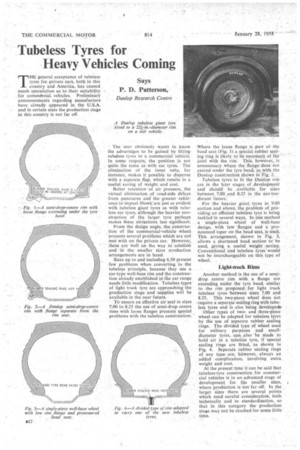Tubeless Tyres for Heavy Vehicles Coming
Page 38

If you've noticed an error in this article please click here to report it so we can fix it.
Says P. D. Patterson,
Dunlop Research Centre THE general acceptance of tubeless tyres for private cars, both in this country and America, has caused much speculation as to their suitability for commdrcial, vehicles. Preliminary announcements regarding manufacture have already appeared in the U.S.A. and in certain sizes the production stage in this country is not far off.
The user obviously wants to know the advantages to be gained by fitting tubeless tyres to a commercial vehicle. In some respects, the position is not quite the same as with car tyres. The elimination of the inner tube, for instance, makes it possible to dispense with a separate flap, which results in a useful saving of weight and cost.
Better retention •Irif air pressure, the virtual elimination of road-side delays • from punctures and the greater resistance to impact blows; are just as evident with tubeless giant tyres as with tubeless car tyres, although the heavier construction of the larger tyre perhaps makes these attractions less significant.
• From the design angle, the construction of the commercial-vehicle wheel presents several problems which are not met with on the private car. However, these are well on the way to solution and in the smaller sizes production arrangements are in hand.
Sizes up to and including 6.50 present few problems whenconverting to the tubeless principle, because they use a car-type well-base rim and the construction already established in the car range needs little modification. Tubeless types of light truck tyre arc approaching the production stage and supplies will be available in the near future.
To ensure an effective air seal in sizes 7.00 to 8.25 the use of semi-drop centre rims with loose flanges presents special problems with the tubeless construction.
Where the loose flange is .part of the head seat (Fig. 1) a.speciaL rubber sealing 'ring is likely to be necessary at the joint with the rim. This, however, is unnecessary where the flange does not extend under the tyre bead, as, with the Dunlop construction shown in Fig. 2.
Tubeless tyres to fit the Dunlop rim are in the later stages of development and should he available for sizes between 7.00 and 8.25 in the rfot-toodistant future.
For the heavier giant tyres in 9.00 section and above, the problem of providing an efficient tubeless tyre is being tackled in several ways. In one method a single-piece wheel of well-base design, with low • flanges and a -pronounced taper on the bead seat, is used. This. arrangement, shown in Fig. 3, allows a shortened bead section to he used, giving a• useful weight saving. Conventional and tubeless tyres would not be interchangeable on this type of wheel.
Light-truck Rims
Another method is the use of a semidrop centre rim with a flange not extending under the tyre bead, similar to the rim proposed for light truck tubeless tyres between 'sizes 7.00 and 8.25. This two-piece wheel does not require a separate sealing ring with tubeless tyres and is also being developab
Other types of twoand three-piece wheel can be adapted for tubeless tyres by the use of separate rubber sealing rings. The divided type of wheel used for military purpOses and smalldiameter tyres, can also be made to hold air in a tubeless tyre, if special sealing rings are fitted, as shown in Fig. 4. Separate rubber sealing rings of any type are, however, always an added complication, involving extra weight and cost.
At the present time it can be said that tubeless-tyre construction for commercial vehicles is in an advanced stage of development for the smaller sizes, where production is not far off. In the larger sizes there are several points which need careful consideratio1s, both technically and to standardization, so that in this category the production stage may not be reached for some little time.




















































































